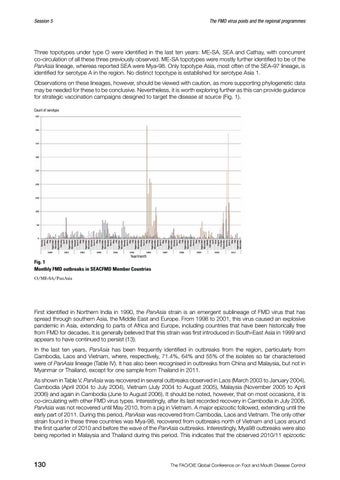Session 5
The FMD virus pools and the regional programmes
Three topotypes under type O were identified in the last ten years: ME-SA, SEA and Cathay, with concurrent co-circulation of all these three previously observed. ME-SA topotypes were mostly further identified to be of the PanAsia lineage, whereas reported SEA were Mya-98. Only topotype Asia, most often of the SEA-97 lineage, is identified for serotype A in the region. No distinct topotype is established for serotype Asia 1. Observations on these lineages, however, should be viewed with caution, as more supporting phylogenetic data may be needed for these to be conclusive. Nevertheless, it is worth exploring further as this can provide guidance for strategic vaccination campaigns designed to target the disease at source (Fig. 1). Count of serotype
Year/month
Fig. 1 Monthly FMD outbreaks in SEACFMD Member Countries O/ME-SA/PanAsia
First identified in Northern India in 1990, the PanAsia strain is an emergent sublineage of FMD virus that has spread through southern Asia, the Middle East and Europe. From 1998 to 2001, this virus caused an explosive pandemic in Asia, extending to parts of Africa and Europe, including countries that have been historically free from FMD for decades. It is generally believed that this strain was first introduced in South-East Asia in 1999 and appears to have continued to persist (13). In the last ten years, PanAsia has been frequently identified in outbreaks from the region, particularly from Cambodia, Laos and Vietnam, where, respectively, 71.4%, 64% and 55% of the isolates so far characterised were of PanAsia lineage (Table IV). It has also been recognised in outbreaks from China and Malaysia, but not in Myanmar or Thailand, except for one sample from Thailand in 2011. As shown in Table V, PanAsia was recovered in several outbreaks observed in Laos (March 2003 to January 2004), Cambodia (April 2004 to July 2004), Vietnam (July 2004 to August 2005), Malaysia (November 2005 to April 2006) and again in Cambodia (June to August 2006). It should be noted, however, that on most occasions, it is co-circulating with other FMD virus types. Interestingly, after its last recorded recovery in Cambodia in July 2006, PanAsia was not recovered until May 2010, from a pig in Vietnam. A major epizootic followed, extending until the early part of 2011. During this period, PanAsia was recovered from Cambodia, Laos and Vietnam. The only other strain found in these three countries was Mya-98, recovered from outbreaks north of Vietnam and Laos around the first quarter of 2010 and before the wave of the PanAsia outbreaks. Interestingly, Mya98 outbreaks were also being reported in Malaysia and Thailand during this period. This indicates that the observed 2010/11 epizootic
130
The FAO/OIE Global Conference on Foot and Mouth Disease Control
















